Students explored historic Scotland in March 2025, blending field study with site visits to Aberdeen, Stirling, and Edinburgh.
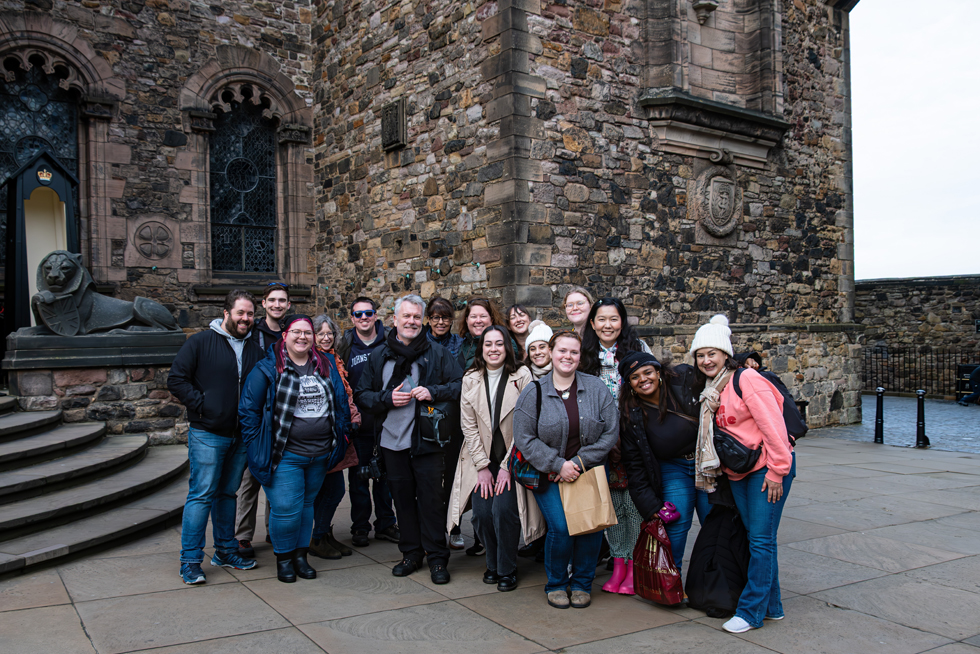
Sixteen MA in Cultural Heritage Management students spent five days in early March of 2025 on a strategic, investigative hopscotch through historic Scotland. Complete with the requisite drizzly, chilly weather, and a sampling of Scotch whisky, the students enjoyed an immersive and impactful expedition of field study and site visits as part of the 15-week three-dimensional technology and documentation course. Many of the students broadened their exposure by wrapping personal exploration of the Highlands, the Isle of Syke, Inverness, and the Orkney Islands around their educational experience.
Led by lecturer Doug Pritchard, they began in Aberdeen in the north, then ventured south to Stirling, and culminated in Edinburgh. Along the way, the students gained valuable experience, and a better understanding of the digital preservation process used to monitor, manage, and protect cultural heritage sites that are under incremental or catastrophic threat.
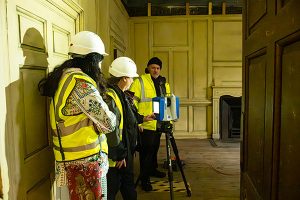
“Being able to see the human experience in the built environment firsthand, to understand the cultural landscape of Scotland from north to south and the multiperiod occupation of these structures was so fascinating,” said Sam Fuller, who currently serves as an officer in the U.S. Army. “I also enjoyed learning about Historical Environment Scotland’s management practices as stewards of the cultural heritage profession and its approach to both preservation and outreach. It is humbling to stand in a structure that old and look at it through a heritage lens, knowing that you are standing on hundreds, if not thousands, of years of human history. I have never seen anything like it.”
An ambitious schedule included stops at the historically significant Dunnottar, Stirling, and Edinburgh Castles, that date back to as early as the 12th century. The group also visited a working site at Bannockburn House and made a stop at Historic Environment Scotland’s Engine Shed, the country’s center of excellence in heritage science and conservation. They even fit in a side trip to Rosslyn Chapel, brought to worldwide prominence through Dan Brown’s novel The Da Vinci Code.
“We talk about ‘aura’ in cultural heritage a lot. It was so incredible to feel the energy around these historical sites and their significance,” said Katharine Rubinetti who was among the 16. “After reading and talking about the 3D laser scanner, being able to see it work helped put a lot of pieces together. It was incredible to witness the dedication of the volunteers. Everyone was so kind and willing to talk to us.” Rubinetti, in fact, hopes to maintain her connection to Bannockburn House by volunteering her time as a freelance grant writer to help drive some critical funds to the site.
The experience went just as Assistant Program Director and anthropologist Angela Labrador hoped it would. By removing the students from the ideals of the classroom, she exposed them to the “messiness of reality.”
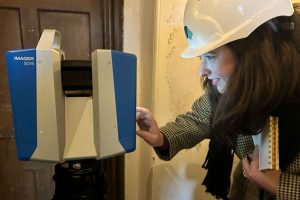
“A very reductionist view of this experience could lead one to think that all you have to do is just find an old place, stick a laser scanner somewhere, press a button, and you’re done. You have a scan, you got some data, and the problem is solved,” said Labrador. “This experience allowed our students to understand how context-specific these projects are, and that if you are going to use 3D technology to document at heritage site, you need to understand the full context of the site. You need to understand the problems that the site is trying to address and solve. Our students were so eager and were soaking in all the information. Our program is lucky to have adjunct faculty, like Doug, developing courses and teaching with us. His professional connections in Scotland through his work at the Scott Sutherland School of Architecture at Robert Gordon University were invaluable to the course, and his portfolio of applied international research in heritage documentation and 3D technology is unmatched. It means our students are learning from a practicing expert in the field and tapping into their professional networks, something that distinguishes our program. The students took advantage of every single minute there. As an educator, it was invigorating to witness.”
“On our travels, we had architects take us around, explaining not only the evolution of the castles, but also the pathology of the buildings, why certain things have changed and what things work and don’t work in terms of dealing with the public,” said Pritchard, a transplanted Canadian who has personally scanned many of Scotland’s 346 A-listed structures that were constructed using Old World technology – stone, slate, and timber – craftsmanship that is incredibly expensive to replicate and maintain.
“I wanted our students to gain an appreciation of the layers of heritage in Scotland – some of the sites dating back to Neolithic times – unlike anything found in the United States. I also wanted them to understand the vital role of Historic Environment Scotland in protecting these sites but also driving tourism, Scotland’s fourth-largest source of revenue after oil, banking, and whisky.
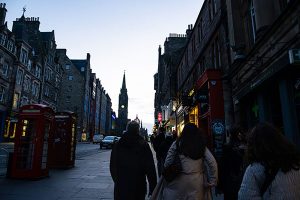
“Beyond that, I hoped they would appreciate the challenges of balancing tourism with building conservation,” he said, “as well as the impact of climate change and financial constraints on conserving the historic structures that define Scotland’s unique identity.”
Time at Bannockburn House allowed the students to see an important historic structure in very difficult conditions, unclean, with water damage and parts of the roof failing. It also allowed them to interact with volunteers on site who are passionate about preserving the local history.
“I think the energy of those volunteers radiated to our students,” Pritchard said. “It was impactful to give them less of a Disney version of cultural heritage and let them see the significant role that a laser scanner and high-resolution digital cameras can play in not only salvaging and digitally preserving buildings, but also in providing interpretation and public engagement.”
The day at Bannockburn House was a standout memory for many on the excursion and not just because the students had the opportunity to operate the expensive ($80,000) laser scanner in the structure itself. They were also able to document revitalization efforts with the site’s historic garden and other ecological issues at what is also an archeological site. The students will end the course by working in small groups to present strategies and practical solutions for incorporating the use of this digital technology to address either a conservation or an outreach challenge at the heritage site.
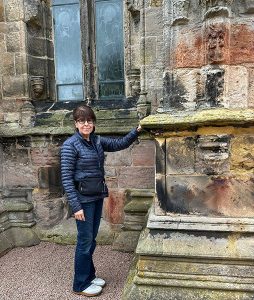
“The immersive portion of the course was so important to me,” said retired physician Mel Macias of her first-ever field experience. “Yes, we are learning how to bring technology into the field, but it doesn’t replace the actual value of being there and experiencing the smells, the sights, the sounds in person. Being there levels the field of understanding about how this technology can be widely applied – to preserve structures, to bring awareness, and to raise funds. Establishing that history is so vital and important and exciting. The chance to meet my classmates as a group changed everything. It was very dynamic. Doug is so passionate about his work and about the way he shares his projects. It validates its importance and applicability. He and Angela were very engaged, and the coordination was flawless. It was pretty fantastic.”
“My only regret — and that of the students — was that we didn’t have more time together as we traveled across the country,” Pritchard said. “It was a fantastic group. They asked thoughtful questions, were enthusiastic and engaged, and conducted themselves with exceptional professionalism — true ambassadors for Johns Hopkins University. I genuinely enjoyed the company of these bright, thoughtful individuals.”